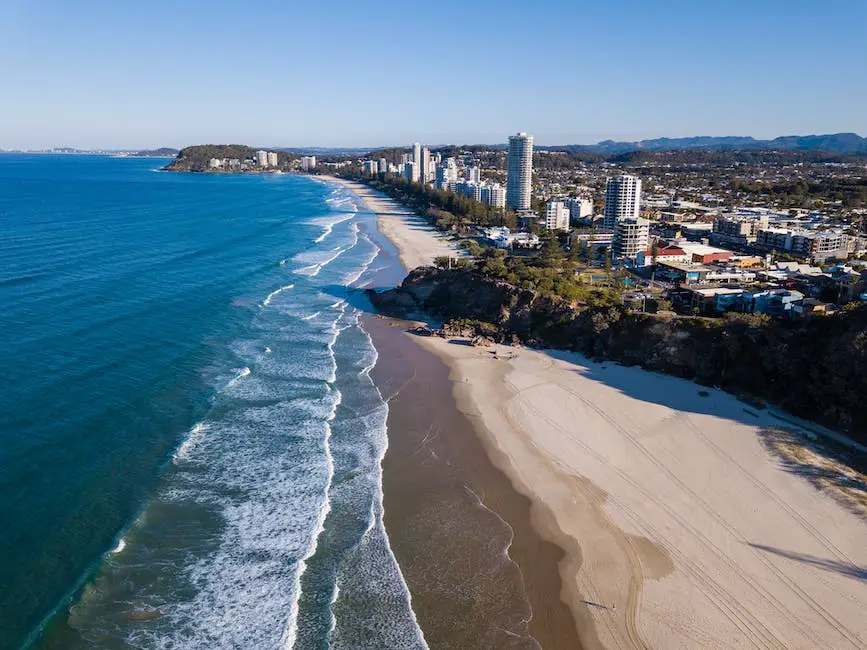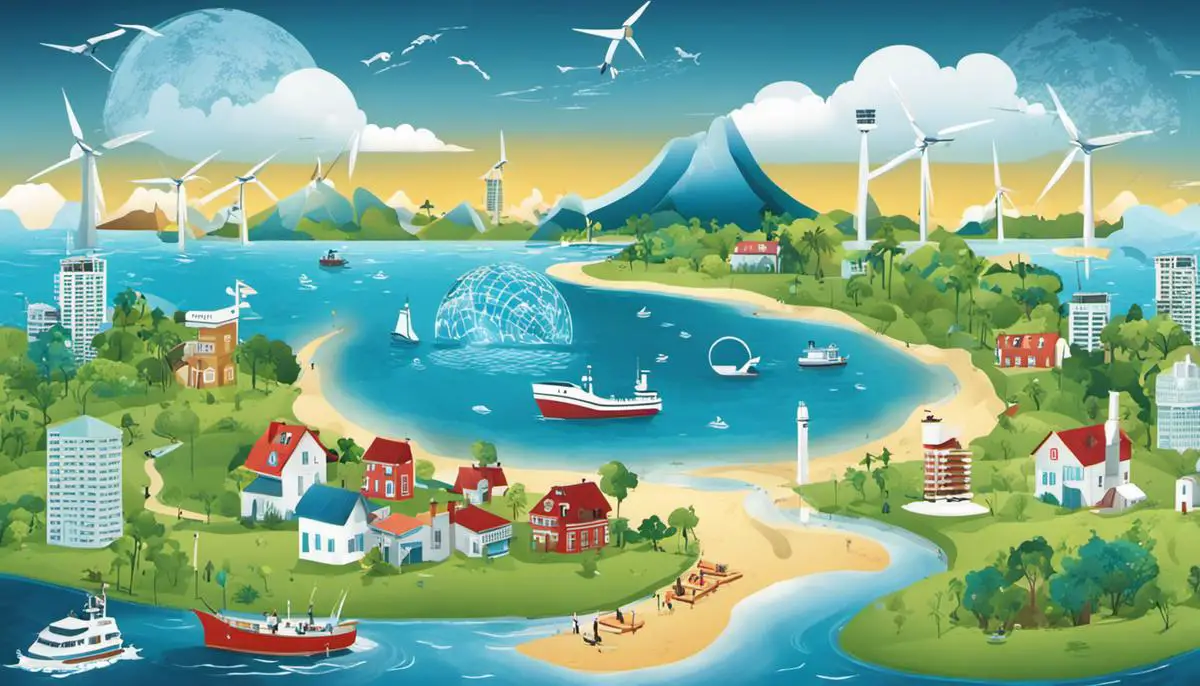An intricately interconnected phenomenon with complex outcomes, sea level rise is a significant challenge that humanity faces in the era of global warming. Driven largely by the melting of glaciers due to elevated global temperatures and thermal expansion, sea level rise poses a potentially devastating threat to coastal populations and ecosystems. As we chart the course of our unfold history, it’s increasingly vital to understand not only the scientific mechanisms behind this phenomenon, but also its historical context, projected future trends, and impacts. Most importantly, recognizing the strategies that can be implemented for mitigation and adaptation helps equip us for the uncertain future we have woven.
Understanding Sea Level Rise
Understanding Sea Level Rise
Sea level rise is an environmental phenomenon where the world’s oceans gradually increase in volume. This occurrence is directly influenced by two primary factors: the melting of ice on land and thermal expansion caused by an increase in ocean water temperature.
The process in which land-based ice – for instance, glaciers and ice sheets in Antarctica and Greenland – melts contributes significantly to rising sea levels. It’s important to note that melting sea ice, such as the Arctic sea ice, doesn’t raise sea levels as it’s already a part of the ocean volume. The principal concern is the melting of ice located on land. When this ice melts, it adds water to the oceans, causing the sea level to rise.
Global Warming and Thermal Expansion
Global warming plays a critical part in sea level rise due to a process called thermal expansion. As the earth’s atmosphere warms, so does the temperature of ocean water. When water is heated, its volume expands. In the context of the world’s ocean, this temperature increase causes a significant expansion of the seawater’s volume, leading to a rise in sea level.
Hotter temperatures speed up the rate of ice melt, leading to more freshwater flowing into oceans. The environmental phenomena are interconnected, where climate change fuels global warming, which accelerates ice melting and thermal expansion, both of which contribute directly to sea level rise.
Projecting Sea Level Rise in 2023
Scientists use data from satellites and tide gauges to monitor current sea levels and project future increases. Current climate models suggest that sea levels will continue to rise due to ongoing thermal expansion and ice melt. In the context of 2023, the projection is that we will continue to witness a measurable rise in sea levels.
The Intergovernmental Panel on Climate Change (IPCC) has predicted ongoing sea level rises into the next century, with varying estimates depending on greenhouse gas emission levels. Under all emissions scenarios, sea level rise will continue beyond 2100—the issue is how much and how quickly. By 2023 we are likely to see an increment consistent with the current pace of sea level rise, around 3.3 mm per year, based on historical data.
Consequences of Rising Sea Levels
Rising sea levels generate disastrous impacts, including increased flood risks, coastal erosion, and loss of habitats for varying species such as birds, fish, and plants. The escalation of saline water into freshwater zones could potentially jeopardize agriculture and jeopardize freshwater supplies located in coastal areas. Coastal cities like Miami and Venice, known for their low-lying territories, are engaging in a strenuous battle against the rising sea levels, investing billions into adaptive measures and infrastructures.
To summarize, the rise in sea levels is a critical, imminent issue that demands substantial and consistent global mitigation endeavors. Irrespective of their role or station, every individual and politician must identify and fulfil their part in combating climate change, thereby contributing to halting or at least slowing down the ascension of sea levels.

Historical Context and Trend of Sea Level Rise
Historic Overview and the Continuous Rise in Sea Levels
Throughout the industrial revolution period, the advent of rising sea levels was noted with critical importance. Rapid industrial progressions resulted in a significant boost in greenhouse gas emissions. This eventually caused a surge in global temperatures, triggering polar ice cap melts.
The 20th century was particularly remarkable for its swift sea level rise, primarily due to the seawater expansion from warmth, the progressive melting of mountain glaciers, and polar ice cap degradation. During this century, an average global sea level rise of 14 to 20 centimeters was recorded, indicating a worrying acceleration. As per reports from the Intergovernmental Panel on Climate Change (IPCC), the pace of the rise doubled, escalating from 1.7 millimeters per year over the period of 1901-1990 to 3.2 millimeters annually during 1993-2010.
Sea Level Rises Beyond 2020
Projecting to the present day and beyond, studies from different scientific communities forecast an amplified rate in the sea level rise, predicting a rise of 20 to 30 centimeters by 2050, and 0.5 to 2 meters by 2100. The year 2023 falls within this trajectory, and continuous monitoring efforts report an ongoing rising trend, increasing the urgency for climate action.
The National Oceanic and Atmospheric Administration (NOAA) estimates that the global mean sea level in 2023 will continue on this accelerating trend, potentially leading to destructive impacts in coastal regions, including increased flooding, saltwater contamination of drinking water, and serious threats to local ecosystems and wildlife.
Measuring Sea Level Rise over the Years
The techniques to monitor sea level rise have evolved over the years. Historical measures include tide gauges, which are devices installed along the coastline to manually measure the changes in sea level. This method provided essential baseline data for the sea-level changes occurring over the last century.
However, modern technological advancements have afforded much more accurate insights. Nowadays, scientists use satellite altimetry to track variations in the sea level on a global scale. By bouncing a microwave pulse off the ocean’s surface and recording the time it takes to return, scientists can gauge the sea level meticulously. This technique has provided consistent and widespread data since the early 1990s.
Historical Approaches to Sea Level Rise
Over time, responses to the rising sea levels have been a blend of mitigation and adaptation strategies. The well-intended mitigation efforts mainly centered on diminishing greenhouse gas emissions, hoping to bring down surface temperatures. This was anticipated to slow the pace of melting polar ice caps and seawater’s thermal expansion. However, despite painstaking endeavors like the Paris Agreement aimed at curtailing greenhouse gas emissions, these initiatives fell short of the required emission reductions to cease the upward trend of sea levels.
Adaptation strategies saw the light of day in the form of sea barriers, coastal reclamation projects and relocating inhabitants from vulnerable coastal regions. These strategies, albeit effective to an extent in mitigating immediate surge impacts, are essentially stop-gap arrangements.
The aggravated situation calls for a dual-pronged approach. It is imperative to carry on with forceful emission reduction efforts while concurrently enhancing adaptive capacities. With this, the society would be better equipped to handle the impending challenges that rising sea levels are predicted to impose in 2023 and future years.

Anticipated Sea Level Rises in 2023
Anticipated Sea Level Rise in 2023
Scientific analytics indicates a persistent rise in global sea levels. Authoritative institutions such as the National Oceanic and Atmospheric Administration (NOAA) and the Intergovernmental Panel on Climate Change (IPCC) forecast a sustained sea level elevation in 2023. The projected surge primarily attributes to thermal expansion – with the water volume expanding in response to rising temperatures – and increased water contribution from melting land ice, specifically from glaciers and ice sheets from polar regions like Greenland and Antarctica.
Factors affecting Sea Level Rises
It’s crucial to understand that the prognosis of sea level rise in 2023 hinges on particular variables. These include the rate of global warming, the rate of ice melt, and the volume of water added to the oceans by melting glaciers. The amount and pace of additional global warming largely depends on how effectively we reduce greenhouse gas emissions. A high emission scenario projects a more significant sea level rise, while low emissions could slow the rate – although not halt it entirely.
Global Warming Rates Influence
The global warming rate is a pivotal factor when anticipating sea level rises for 2023. Thermal expansion is exclusive to the top layer of the ocean, and as global temperatures increase, more oceanic zones are susceptible to this expansion, subsequently raising the sea level further. Research indicates a definitive relationship between coastal flooding and a warming climate.
Ice Melt and Sea Level Rises
Ice melt rates, particularly in Greenland and the Antarctic, play a crucial role in estimating sea level rise for 2023. These ice bodies have been melting at accelerated rates over the past few decades due to rising atmospheric and oceanic temperatures. The increased melting contributes a significant amount of additional water to the ocean, raising its overall level.
Sea Levels and the Role of Glaciers
Glaciers worldwide are also contributing to the rising sea levels. Like Greenland and Antarctica, many of these smaller ice bodies are melting at an increased pace, and their meltwater is ending up in the ocean. This reduced ice mass from glaciers worldwide contributes significantly to the overall sea level rise projection for 2023.
Local Variations in Sea Level Rise
It’s critical to note that the rise in sea level doesn’t occur uniformly worldwide. Certain regions such as the Eastern Seaboard of the United States and areas within the Pacific are at a greater risk. Factors at a regional level such as changes in ocean currents, sinking land due to excessive groundwater extraction, and even shifts in the Earth’s crust due to the redistribution of mass on its surface all join to influence local sea level projections. These predictions suggest that by 2023, some areas may experience a sea-level rise exceeding the global average.

Implications and Impacts of Sea Level Rise
The Wide-Ranging Impact of Rising Sea Levels
The predicted rise in sea levels can have far-reaching impacts on both mankind and natural environments. These impacts are diverse and widespread, with potential effects including increased risk of flooding and dramatic erosion of coastal landscapes. Of particular note is the effect rising sea levels could have on global climate patterns.
Alterations in sea levels can intensify extreme weather conditions, representing a direct result of climate change. Coastal zones that are densely populated and low-lying are likely to face the brunt of these changes. The resulting changes can lead to mass displacement of communities and disruption of livelihoods, potentially sparking environmental refugee situations.
The anticipated increase in flooding frequency is one of the most immediate and visible effects of a rising sea level. Coastal cities, by 2023, may face a rise in high-tide flooding events, also known as nuisance flooding. This is attributed to the gradual sea level rises. Unlike devastating events such as hurricanes, these minor flooding incidents could potentially culminate into significant damage over time.
Coastal Erosion and Environmental Crisis
Erosion of the coastlines is another imminent result of rising sea levels. The seashores serve as the frontline of defense against the ocean’s waves. The higher sea levels suggest that waves break further inland, leading to increased coastal erosion. This phenomenon threatens coastal homes, infrastructure, and wildlife, thereby bringing a looming environmental crisis that could disproportionately affect regions with less resilient infrastructure.
Case Study: The Pacific Islands
The islands in the Pacific are among the regions most threatened by sea level rises. Many of these islands are barely meters above the current sea level and an increase could render them uninhabitable. According to studies, some regions have already witnessed a sea level rise of approximately 8-14 millimeters per year over the past three decades.
This constant rise of sea levels within these regions has disrupted traditional ways of life, led to the loss of land and caused freshwater resources to become contaminated with saltwater. These factors among others have led to an increasing number of environmental refugees, with individuals or entire communities forced to move due to changes in their local environments.
Understanding Sea Level Rise and Its Impact on Global Climate
The increasing frequency of sea level rises is a pressing global issue, pivotal to the changes we observe in climate conditions. Most often, sea level increases are the by-products of escalating worldwide temperatures that lead to the melting of ice caps and glaciers, consequently expanding the volume of the oceans. In tandem with the seawater’s natural thermal expansion due to the heat, these occurrences contribute significantly to the fluctuating sea levels.
Moreover, this phenomenon known as thermal expansion plays a considerable role in influencing ocean currents, critical regulators of the world’s weather pattern. Any disruption to these ocean currents could magnify extreme weather events and lead to unexpected and drastic shifts in our climate. This potentially catastrophic scenario highlights the urgency of addressing sea level rise in the years beyond 2023.

Mitigation and Adaptation Strategies
Implementing Mitigation Efforts: The Role of Government Policies and International Cooperation
To effectively confront and curtail sea level rises, multi-tiered strategies are necessitated, encompassing both international and governmental initiatives. At the international level, accords like the Paris Agreement – unanimously endorsed by more than 190 countries, committing to lower their individual greenhouse gas emissions – represent significant steps in addressing the adverse effects of climate change.
Simultaneously, governments all over the world are rolling out policies to minimize harmful emissions. For instance, the United States enforced the Clean Power Plan in 2015, specifically designed to decrease carbon pollution produced by power plants. Nations like Sweden and Norway are setting impactful examples by implementing strict laws to phase out fossil fuel usage, instead opting for alternative renewable energy sources. Furthermore, numerous governments are exploring carbon pricing as a potential solution, effectively assigning a financial cost to carbon emissions, consequently discouraging pollution.
Innovation & Technology: A Proactive Approach
Technological innovation is key to mitigating sea-level rises. Carbon capture and storage technology, for instance, offers significant potential to reduce greenhouse gas emissions. On the other hand, alternate energy sources, such as wind, solar, and hydroelectric power, are increasingly being adopted to reduce reliance on fossil fuels.
In 2023, innovations such as satellite monitoring of the ocean’s surface, solar geoengineering, and cloud brightening are among the arsenal of technological advancements in this battle. Geoengineering techniques are promising but are still in the testing and development phase.
Local & Community-Led Initiatives
Local and community-led initiatives are equally important in the fight against rising sea levels. These initiatives often involve local conservation programs, including measures like mangrove planting and coastal zone management.
For instance, in Florida, stakeholders are partnering to form the Southeast Florida Regional Climate Change Compact. This collaboration marks a significant step toward addressing climate change impacts at a local level. Similarly, in California, the Resilient Coastlines Project enables communities to tackle rising sea levels through local planning and implementation.
Adaptation Strategies: From Sea Barriers to Climate-Resilient Infrastructure
Adapting to sea-level rises involves strategies such as the building of sea barriers, dykes, and flood resistance infrastructure. For example, the Netherlands has an impressive array of sea barriers and dykes, effectively making it a global leader in flood management and climate resilience.
Meanwhile, cities like New York and Miami are investing in climate-resilient infrastructures such as sea walls, elevated roads, and stormwater pumps.
Reforestation is another crucial adaptation strategy. Planting trees and preserving existing forests can take significant amounts of carbon dioxide out of the atmosphere, helping to mitigate climate change. This tree-planting approach is evident in Costa Rica, which has reversed its deforestation trend and now boasts more than 50% forest cover.
Utilizing natural climate solutions, such as restoring wetlands and mangroves, also offers a cost-effective approach to building climate resilience. These ecosystems absorb and store carbon at up to five times the rate of tropical forests, making them a vital tool in addressing climate change.
Overall, while the situation is urgent, many strategies are in play to combat and adapt to sea level rises.

Fully understanding the mechanisms behind sea level rise, taking stock of our historical learnings, preparing for imminent rises, and grasping its wide-ranging implications allows us to confront the challenge with a deeper awareness. With a clearer vision of what’s ahead, we can not only innovate our strategies for mitigation but also evolve our means of adaptation. It is through this blend of scientific insight, historical knowledge, anticipation, and strategic planning that we can navigate through the tricky waters of sea level rise. While sea level rise is an undeniable outcome of our industrialized society, it is important to remember that the potential solutions and adaptations for the future are within our grasp and can help chart a resilient path forward in a changing world.
![]()
